Stories of Korea’s nine seowon
Introduction to 9 seowon, UNESCO World Heritage Sites
Meticulous preservation
of curriculum content and booksOksanseowon Gyeongju (Historic Site No. 154)
Oksanseowon is one of the few that survived the closing down of seowon in 1871, the eighth year of King Gojong. It also avoided damage by gunfire from a key battleground of the Korean War (Angang, Gyeongju). Oksanseowon is a key seowon in terms of book preservation as it still has a diverse range of valuable books which are in good condition.
All sound files
Important functions of seowon
- Outline
- Veneration
- Learning
- Interaction
- Other aspects
Outline
Oksanseowon is one of the few that survived the closing down of seowon in 1871, the eighth year of King Gojong. It also avoided damage by gunfire from a key battleground of the Korean War (Angang, Gyeongju).
Oksanseowon is a key seowon in terms of book preservation as it still has a diverse range of valuable books which are in good condition.
Oksanseowon is a key seowon in terms of book preservation as it still has a diverse range of valuable books which are in good condition.

Scenery of Oksanseowon
Oksanseowon was founded in 1572 by sarim of Gyeongju who wanted to honor the learning and loyal spirit of Yi Eon-jeok (1491-1553). It became a royally sponsored seowon in 1573, during the reign of King Seonjo.
Facing west, Oksanseowon is surrounded by mountains on three sides: Hwagaesan Mountain (east), Jaoksan Mountain (west), and Dodeoksan Mountain (north). The southern side is clear of natural features. Jagyecheon Stream flows past the front of the seowon. One notable feature is a large rock, called “Sesimdae,” which Yi Hwang described as a place where “one can wash away the impurities of the heart with clean water and focus on study with nature in the background.” King Jeongjo once supposedly ordered the conducting of an early-stage exam (which is called “chosi” in Korean) for the civil service examination here to honor the accomplishments of Yi Eon-jeok.
After entering the main gate, to go to Mubyeonnu, one has to cross a narrow gully of water brought from the upper areas of Jagyecheon Stream to the northern wall of the seowon. The pavilion, Mubyeonnu, was the first to be constructed on the premises of a Korean seowon. After going under Mubyeonnu and climbing the stone stairs, one arrives at the rectangular learning space (between Mubyeonnu and Guindang), in which the student dormitories (Dongjae and Seojae) face each other. Guindang, the learning hall, which has a roof with raised edges and a width of five kan and a depth of two kan (a traditional unit of architectural measurement that refers to the space been two columns), stands on a stone stylobate.
Guindang features the writing of noted individuals: the name board under the eaves that reads “Oksanseowon” was written by Kim Jeong-hui. Another Oksanseowonname board hanging at the daecheongmaru and inscribed with “Oksanseowon” was written by Lee San-hae, a bureaucrat who was known for his calligraphy. The “Guidang” and “Mubyeonru” name boards in the inner corner of the daecheongmaru were written by Han Seok-bong.
Facing west, Oksanseowon is surrounded by mountains on three sides: Hwagaesan Mountain (east), Jaoksan Mountain (west), and Dodeoksan Mountain (north). The southern side is clear of natural features. Jagyecheon Stream flows past the front of the seowon. One notable feature is a large rock, called “Sesimdae,” which Yi Hwang described as a place where “one can wash away the impurities of the heart with clean water and focus on study with nature in the background.” King Jeongjo once supposedly ordered the conducting of an early-stage exam (which is called “chosi” in Korean) for the civil service examination here to honor the accomplishments of Yi Eon-jeok.
After entering the main gate, to go to Mubyeonnu, one has to cross a narrow gully of water brought from the upper areas of Jagyecheon Stream to the northern wall of the seowon. The pavilion, Mubyeonnu, was the first to be constructed on the premises of a Korean seowon. After going under Mubyeonnu and climbing the stone stairs, one arrives at the rectangular learning space (between Mubyeonnu and Guindang), in which the student dormitories (Dongjae and Seojae) face each other. Guindang, the learning hall, which has a roof with raised edges and a width of five kan and a depth of two kan (a traditional unit of architectural measurement that refers to the space been two columns), stands on a stone stylobate.
Guindang features the writing of noted individuals: the name board under the eaves that reads “Oksanseowon” was written by Kim Jeong-hui. Another Oksanseowonname board hanging at the daecheongmaru and inscribed with “Oksanseowon” was written by Lee San-hae, a bureaucrat who was known for his calligraphy. The “Guidang” and “Mubyeonru” name boards in the inner corner of the daecheongmaru were written by Han Seok-bong.
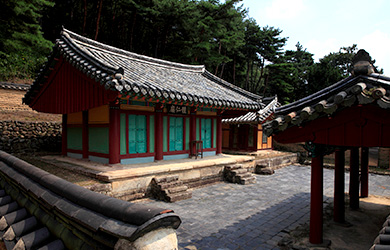
Cheinmyo
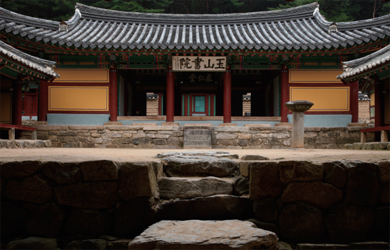
Guindang
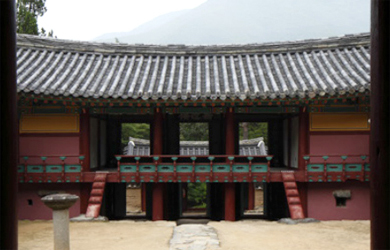
Mubyeonnu
Behind Guindang is a shrine (Cheinmyo) that holds the ancestral tablets of Yi Eon-jeok. The name’s Chinese characters, (體仁) pronounced “chein” in Korean, mean “to put into practice a pure and kind heart,” which is the cornerstone of Yi’s philosophy of practicing one’s values. Yi is revered as one of the “five wise men of the East” of the Joseon dynasty, along with Kim Goeng-pil, Jeong Yeo-chang, Cho Gwang-jo, and Yi Hwang.
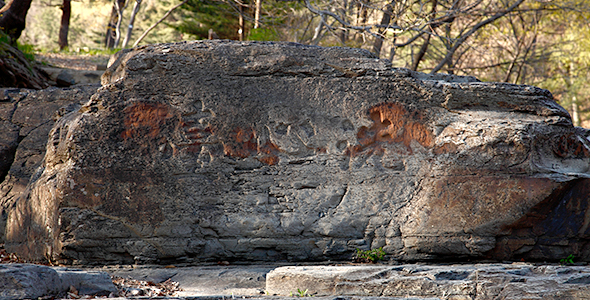
Sesimdae
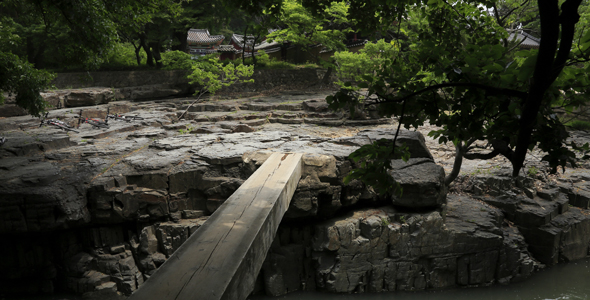
Scenery of Sesimdae
If you go about 700 meters along Jagyecheon Stream in a northwesterly direction from Oksanseowon, you will see Dokrakdang, Treasure No. 413. It is where Yi, after retiring from office, spent his days reading books alone while surrounded by nature. It is here that Yi calmed his stressful thoughts, washed the strings of his horsehair hat to show his absolution of the cares of worldly life, watched fish swim, and enjoyed the cool breeze while singing poems.
Surrounded by a clay wall with a closable door, Dokrakdang has a small window in the rear wall that looks over a stream, which offers a pleasant experience for both the eyes and ears.
Oksanseowon is included in two UNESCO World Heritage Sites: “Historic Villages of Korea: Hahoe and Yangdong (2010)” and “Seowon, Korean Neo-Confucian Academies (2019).”
Surrounded by a clay wall with a closable door, Dokrakdang has a small window in the rear wall that looks over a stream, which offers a pleasant experience for both the eyes and ears.
Oksanseowon is included in two UNESCO World Heritage Sites: “Historic Villages of Korea: Hahoe and Yangdong (2010)” and “Seowon, Korean Neo-Confucian Academies (2019).”
Veneration at Oksanseowon
The Chunchuhyangsa of Oksanseowon began at 1 a.m. Before the ritual, officiants were given a light snack of thin rice porridge (called “yaha”) to remove the bad breath that may occur because of hunger.
Another unique aspect was putting the meat served as ritual offerings onto wooden “shelves” and distributed to Mubyeonru, a pavilion, the learning spaces, and even the shrine via wooden ladder through the gate.
Chunchuhyangsa is held every year in February and August.
Another unique aspect was putting the meat served as ritual offerings onto wooden “shelves” and distributed to Mubyeonru, a pavilion, the learning spaces, and even the shrine via wooden ladder through the gate.
Chunchuhyangsa is held every year in February and August.
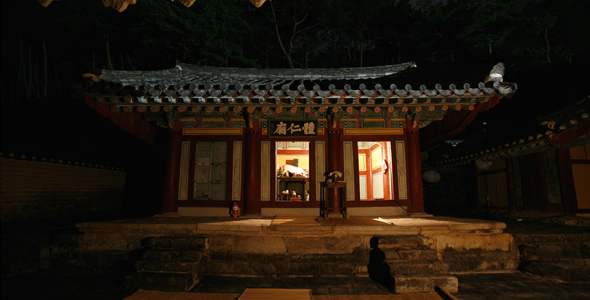
Cheinmyo
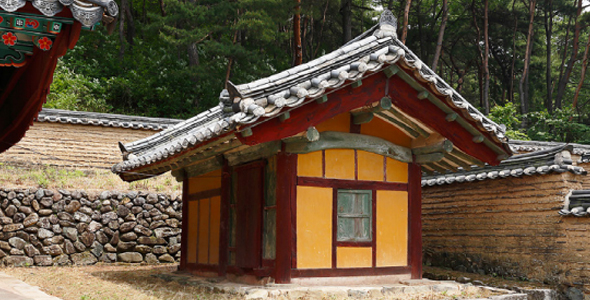
Jeonsacheong
Venerated individuals
Yi Eon-jeok, an individual who is honored by the Oksanseowon shrine, was a Neo-Confucian scholar who immersed himself in the study of “existence theory” and universe theory. He also taught Neo-Confucian theory at the royal court. Yi’s learning was later passed down to Yi Hwang. Yi Eon-jeok was later exiled to Ganggye in Pyeongan-do, where he wrote many books for which he is famous even today. Above all, Yi dreamed of a country of moral ideals and did not hesitate to give advice to the king that was sometimes scathing but always meant to be instructive. His most famous petition was written in 1538 to King Jungjong, in which he outlines 10 principles for ruling the country, including: managing the affairs of one’s household, raising the crown prince properly, accepting honest feedback from the people, being wary of extravagance and greed, and keeping the country well-protected and the people happy. King Jungjong is said to have vowed to keep the petition close at all times. This petition, also called a “maninso,” or a petition that was signed by 10,000 individuals in criticism of a state policy that strays from Confucian teaching, includes the names of 8,849 sarim members. It survives today and is kept at Oksanseowon.
Learning at Oksanseowon
Surviving documents on Oksanseowon’s admission requirements and educational assessment methods provide a great deal of detail on how Oksanseowon taught its students. There is a particularly rich array of documents on how students were selected and graded in terms of academic work, including a list of recommended students and the people who recommended them. The documents suggest that recommendations were made at the seowon’s spring and fall gatherings. The gangji, an assessment resource, was a list of exam scores. It shows that students’ exams were graded per subject using a four-level system, and that the individual doing the grading signed his name.
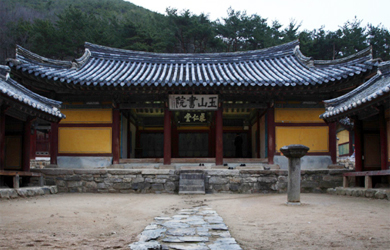
Guindang
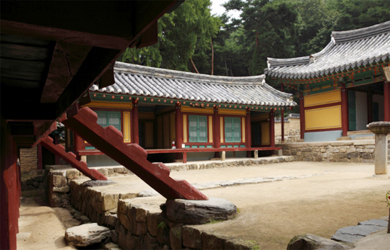
Mingujae
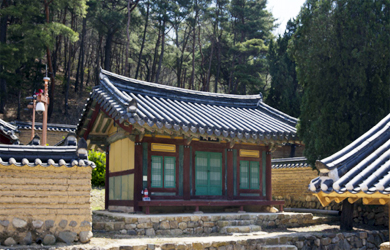
Gyeonggak

Guindang
Interaction at Oksanseowon
Mubyeonru, the pavilion where students went to relax, was originally named “Napcheongnu,” which means “going to this pavilion will impart positive energy to the visitor and lead to an understanding of truth.” Opening the pavilion’s windows that face Jaoksan Mountain revealed a beautiful view of a stream and mountain. At Oksanseowon, students focused their mental energy on learning the teachings of great scholars amid a beautiful natural environment and also spent time debating what it means to live a life of righteousness and integrity.
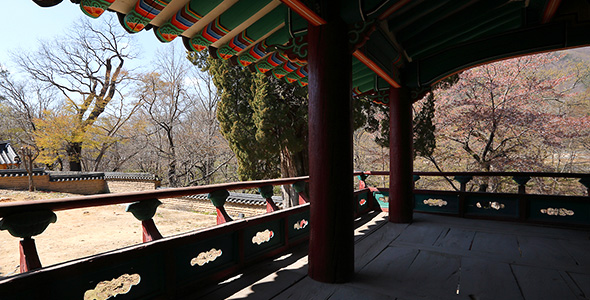
Mubyeonnu

Scenery of area near Sesimdae
Other aspects (cultural heritage items and memorial objects)

Samguksagi (National Treasure No. 322-1)
Oksanseowon received books from the king on eight occasions. It was able to preserve over 6,000 ancient texts and resources by forbidding anything from being taken outside the seowon. Its complete, nine-volume copy of Kim Bu-sik’s Samguk Sagi (Memorabilia of the Three Kingdoms) is designated as Treasure No. 525. Yi Eon-jeok’s handwritten copy is Treasure No. 586, a printed copy of 正德癸酉司馬榜目 (Jeongdeokgyeyusamabangmok, which is a list of names of individuals who passed the Samasi exam in early Joseon) from 1513 is Treasure No. 524, and two volumes of 海東名蹟 (Haedongmyeongjeok, a collection of legal writings by esteemed writers) are Treasure No. 526.
